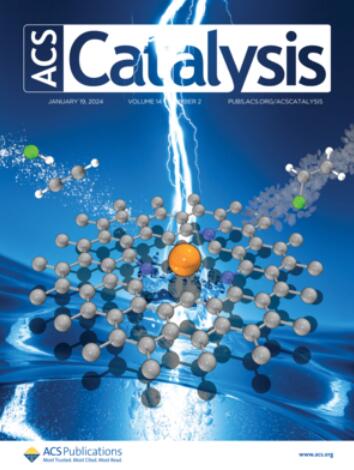Triangulene Synthesis Made Simple on Single-Atom-Doped Gold and Silver Surfaces
IF 11.3
1区 化学
Q1 CHEMISTRY, PHYSICAL
引用次数: 0
Abstract
Triangulene, the smallest triplet-ground-state polybenzenoid, has previously been successfully synthesized by tip-manipulation experiments, employing scanning probe techniques to dehydrogenate precursor molecules under ultrahigh vacuum and low-temperature conditions. Here, we propose an alternative approach to form triangulene on (111)-facets of gold and silver doped by single noble metal atoms (Ru, Rh, Pd, or Pt), predicted by density functional theory calculations in combination with microkinetic analysis. Our results convey two key insights. First, the isolated single atoms reduce the activation energies for the dehydrogenation of dihydrotriangulene (the precursor molecule) and make the reactions more favored compared to pure Au(111) and Ag(111). In particular, we find that Rh- and Ru-doped surfaces outperform other considered single-atom-doped surfaces with nearly 100% yield of triangulene when the initial coverage of precursor is low. Second, two independent descriptors─the H and intermediate adsorption energies─are found to predict the triangulene formation activity on the single-atom-doped surfaces via scaling relations for activation and reaction energies. Based on these descriptors, a two-dimensional yield map for triangulene formation is constructed, providing valuable design insights for experimentalists. Our theoretical work suggests a straightforward thermal synthesis pathway for triangulenes, offering a more efficient alternative to prevalent tip-induced manipulation techniques and high-temperature approaches.

在单原子掺杂的金银表面简单合成三角木烯
Triangulene是最小的三基态多苯类化合物,在超高真空和低温条件下,利用扫描探针技术对前体分子脱氢,成功地通过尖端操作实验合成。在这里,我们提出了一种替代方法,通过密度泛函理论计算结合微动力学分析预测,在单贵金属原子(Ru, Rh, Pd或Pt)掺杂的金和银的(111)面上形成三角烯。我们的研究结果传达了两个关键的见解。首先,孤立的单原子降低了二氢三角烯(前体分子)脱氢的活化能,使反应比纯Au(111)和Ag(111)更有利。特别是,我们发现当前驱体的初始覆盖率较低时,Rh和ru掺杂表面的三角烯产率接近100%,优于其他被考虑的单原子掺杂表面。其次,发现两个独立的描述符──H和中间吸附能──通过活化能和反应能的标度关系来预测单原子掺杂表面上三角烯的形成活性。基于这些描述符,构建了三角烯形成的二维屈服图,为实验人员提供了有价值的设计见解。我们的理论工作为三角烯提供了一种直接的热合成途径,为普遍的尖端诱导操作技术和高温方法提供了一种更有效的替代方法。
本文章由计算机程序翻译,如有差异,请以英文原文为准。
求助全文
约1分钟内获得全文
求助全文
来源期刊

ACS Catalysis
CHEMISTRY, PHYSICAL-
CiteScore
20.80
自引率
6.20%
发文量
1253
审稿时长
1.5 months
期刊介绍:
ACS Catalysis is an esteemed journal that publishes original research in the fields of heterogeneous catalysis, molecular catalysis, and biocatalysis. It offers broad coverage across diverse areas such as life sciences, organometallics and synthesis, photochemistry and electrochemistry, drug discovery and synthesis, materials science, environmental protection, polymer discovery and synthesis, and energy and fuels.
The scope of the journal is to showcase innovative work in various aspects of catalysis. This includes new reactions and novel synthetic approaches utilizing known catalysts, the discovery or modification of new catalysts, elucidation of catalytic mechanisms through cutting-edge investigations, practical enhancements of existing processes, as well as conceptual advances in the field. Contributions to ACS Catalysis can encompass both experimental and theoretical research focused on catalytic molecules, macromolecules, and materials that exhibit catalytic turnover.
 求助内容:
求助内容: 应助结果提醒方式:
应助结果提醒方式:


